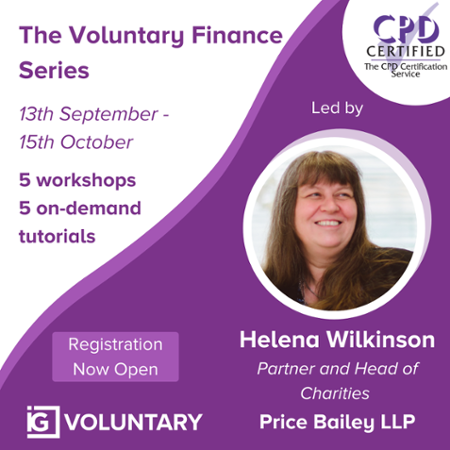Post-COVID Financial Resilience Across the Voluntary Sector
We sat down with Helena Wilkinson, Partner, Price Bailey LLP, to reflect on how the world has changed since her blog on enhancing financial resilience in 2019.
Back in 2019, before the COVID-19 pandemic, you wrote a piece for the IG Voluntary blog on ‘Enhancing Resilience Across the Voluntary Sector’. Nobody could have foreseen how relevant and important financial resilience would be to charitable organisations of all sizes, however it seems as though you were ahead of the game. Why did you feel resilience was so important back then?
Let’s think about the definition of resilience. Financial resilience is about the way that successful organisations deal with inevitable and unforeseen interactions, issues and opportunities in running their business and have the ability to rebound from a financial shock. All organisations will experience a challenge on their ability to survive at some point in their existence. With charities this ‘shock’ can be seen as ongoing. In order to ensure that a charity can continue to deliver on its strategic objectives, it has to understand where it’s next funds will come from – very few charities earn income from their activities - most have to find the income in order to be able to deliver their activities. Therefore, for me resilience in the charity sector has always been paramount.
Every charity needs to think about and plan its future – this involves the creation of a strategic plan which is linked to the income generation of the organisation, its resources and reserves which feed into a budget for its delivery. A key aspect of this process is where will the income come from? Hence the need to be prepared for resilience - the need to anticipate issues, adapt, evolve and change - usually driven by income generation.
Given the huge impact of the pandemic on the voluntary sector, how would you say organisations have responded to the disruption COVID-19 has caused? Is there anything that you think could have or should have been done differently with hindsight?
The Charity Commission has tasked Yonder with carrying out Trustee Research 2021. This has some stark revelations in the sample selected – 16% ceased their activities during COVID; (25% ceased in those with incomes under £10K); 43% ceased at least one of their activities, 38% moved their activities online, 17% started new activities to help with the pandemic and 23% used their reserves to fund their charitable activities.
Many charities, as has society as a whole, learnt new skills, new ways of delivering our services and charitable activities and are much more digitally active than previously. In hindsight, we have heard that many organisations, as well as charities, have embraced the digital media and created their digital strategy. There is a question as to why this was overlooked in the past and perhaps this needs more focus and attention regardless of the pandemic. There are new ways of working and accessing services, funders, donors, and beneficiaries that mean the way charities generate income and deliver on their strategic objectives has changed. Charities need to plan as to how to engage with their supporters and donors in a virtual world – how do you fundraise effectively in a virtual environment? How will fundraising events happen in the future? Many charities will keep online fundraising events as well as the more commonplace actual events taking a hybrid approach in the future. Society is more accepting of digital interactions now.
How do you feel the ways that charities can look to generate more sustainable and resilient incomes has changed over the past 18 months? Are there any routes of income diversification that lend themselves to the post COVID landscape?
Every charity will have its own unique income risk profile. Some income is more inherently risky such as legacy income and its predictability as you can only know of its existence when you are notified by the estate funds will flow. Other income may be less risky such as a residential care home where its fees are predictable however voids will play a part as will cash collection perhaps in understanding the income generation of that organisation.
Income risk is simply about asking yourself lots of questions to understand the risk around each income source, and then documenting this in a meaningful fashion.
So, for example, let’s consider donation income from trusts and foundations. How much has been agreed and signed for in grant agreements, how much is promised or work in progress to finalise the agreement, and how much is purely speculative? Similarly, each other income line or category will have income risk within it to a greater or lesser degree.
Therefore, when you look at your organisation do you understand the income risk of each aspect of your funding and what could make that income increase, decrease, or simply stop? Working your way through that process gives you an idea of how risky your income generation is s well as where your income comes from. Does it all arise from one type of activity or source? Is this an issue? Do you need to seek other sources of income to manage that risk?
If income plans are not being achieved, the organisation needs to consider how it will deal with this situation – be it use reserves, recruit additional resource to generate income, seek new income sources, consider mergers and collaborations, or cut costs. One of the key aspects of managing the risks is building resilience into the organisation by not being overly dependent on one type of income and building an earnt income into the structure – from trading or better still charitable income.
There is no magic bullet which solves income generation – each charity must work hard on building its own picture of how and where from it will raise income. The challenges remain, some aspects mean more innovation – like online fundraising – to keep funds flowing but it is all about planning, setting realistic targets and allocating appropriate resources to your plan.
Given how uncertain the last 18 months have been, if there were 3 bits of advice you could give to charities who are worried about their post-COVID recovery, what would they be?
1) Produce a strategic plan and keep it live – use it to help deliver the strategy.
2) Understand your income risk and have an income generation plan – who will raise the funds and from where? Monitor that this ‘fundraising’ plan is on track and delivering.
3) Reporting – ensure you keep on top of your finances – this is crucial. The board needs to take active responsibility for managing the finances of the organisation which requires reacting to and dealing with the actual results in the management accounts and how this affects the future strategy and plans of the organisation. It is important for the Board to be aware of the difference in budgets of guaranteed income versus pipeline versus guestimated. This is important to understand the income risk that the budget has within it and to monitor that risk over the year. A budget is just looking at a yearly snapshot and this information should also be clear, with speculation and assumptions included in any such figures. Many organisations may look at longer term income forecasts and budgets which help plan for the longer term. Each set of management accounts needs to continue to inform the board with an update against each of these income streams and their risk of achievement as the year progresses. This helps then understand and make informed decisions around whether the budget can be delivered, or if actions need to be taken like reducing costs. A good reserves policy will also help the organisation in monitoring and managing its income risk in both the current year and future years, informing the strategy and decision making.
If you are interested in learning more about how to build financial resilience in your charity, Helena Wilkinson is the lead trainer of the Integrating Resilient Income Strategies Into Your Charity: Voluntary Finance Series.




